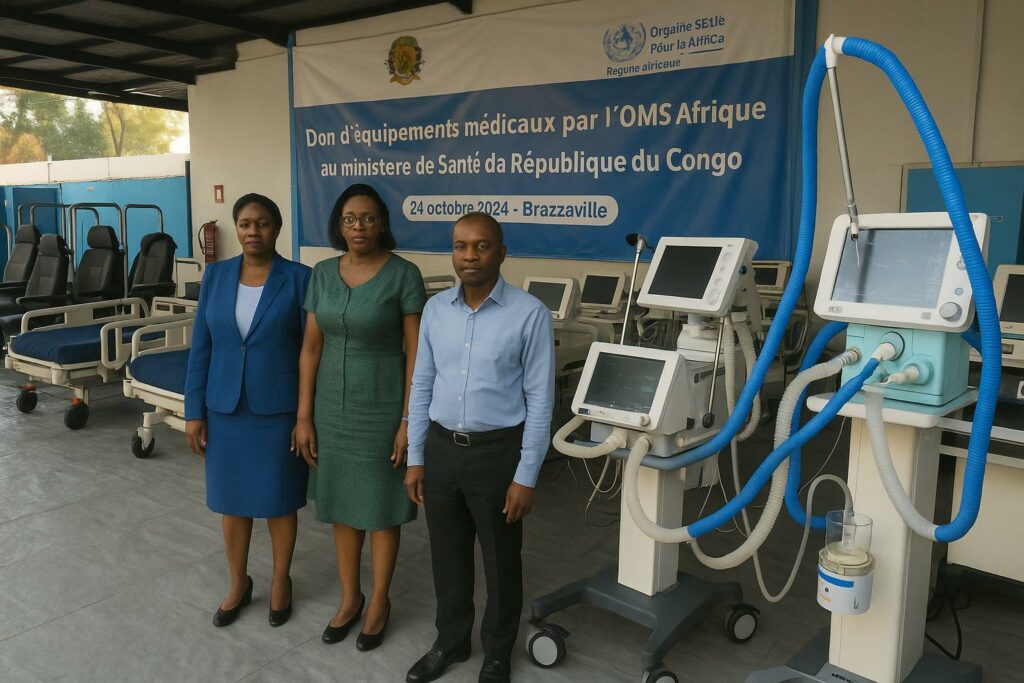A strategic infusion of critical-care technology
In a ceremony marked by carefully weighted protocol, the Regional Director of the World Health Organization for Africa, Professor Mohamed Yakub Janabi, handed over a consignment of intensive-care equipment to the Congolese Minister of Health and Population, Professor Jean Rosaire Ibara. Valued at 280 million CFA francs, the allocation comprises next-generation ventilators, oxygen concentrators, multi-parameter monitors, ICU beds and replacement parts destined for public referral hospitals. The gesture, Janabi insisted, reflects a commitment to “permanent preparedness”, a lesson painfully etched into the continent’s collective memory by successive waves of respiratory epidemics.
While the headlines may focus on the new respirators, the real story lies in a subtle recalibration of the national emergency architecture. By supplying interoperable devices compliant with WHO norms, the organisation enables Congolese clinicians to stabilise patients suffering from acute respiratory distress, cardiac decompensation or polytrauma with a degree of reliability once unavailable outside Brazzaville University Hospital.
From pandemic vigilance to structural resilience
The donation arrives at a pivotal juncture. The government is finalising two newly built general hospitals—one in the southern corridor, the other in the northern growth pole—designed to decongest the capital and narrow geographic disparities in access to specialised care. Minister Ibara welcomed the timing, affirming that the equipment “reinforces our emergency platform just as we prepare to inaugurate facilities that symbolise the next chapter of universal health coverage”.
Observers note that the Congo-WHO partnership has evolved from episodic outbreak response to a more programmatic approach centred on health-system strengthening. By aligning material support with the national strategy for primary healthcare revitalisation, the organisation positions the country to absorb future shocks without shifting focus away from chronic disease management.
Deployment roadmap and training proviso
According to Dr Vincent Dossou Sodjinou, WHO Representative in Congo, the devices will be distributed according to a needs-based assessment that privileges regional equity and case-load data. Biomedical engineers seconded by WHO will accompany the roll-out to ensure installation, calibration and maintenance conform to international standards, while nursing teams will undergo simulation-based training in airway management and hemodynamic monitoring. The ministry has earmarked a budget line for consumables, signalling that the recurring costs of oxygen, filters and circuits have been factored into the national health-financing envelope for 2024.
À retenir
The 280-million-CFA grant underscores Congo’s diplomatic leverage within multilateral health forums and illustrates the tangible dividends of sustained engagement in global health security mechanisms. Beyond the symbolic exchange of plaques and signatures, the infusion of hardware into provincial ICUs marks a quiet but decisive upgrade of the country’s clinical capabilities.
Legal and economic considerations
Under Congolese procurement law, gifts in kind to the state’s health sector must be registered with the Directorate of Public Assets before deployment. The ministry confirmed that the inventory process is underway, thereby safeguarding traceability and limiting exposure to allegations of misuse. Economically, the donation offsets foreign-exchange outflows on imported biomedical technology, freeing fiscal space that can be reallocated to human-resource retention or the expansion of the national drug formulary. The macroeconomic effect may appear modest, yet it reinforces debt-sustainability efforts by substituting grant-based capital for loan-financed expenditure.
A partnership calibrated for the long term
Professor Janabi closed the ceremony by reiterating that WHO’s support remains available “whenever necessary”. The statement, though diplomatic in tone, signals a readiness to anchor the relationship in technical cooperation rather than episodic aid. As Congo prepares to operationalise its new hospitals, the continuous dialogue with WHO offers a channel for policy advice on oxygen ecosystems, tele-ICU solutions and quality-of-care metrics. In the measured words of Minister Ibara, the donation is “an accelerator, not an end point”, favouring a trajectory in which modern infrastructure, properly equipped and staffed, becomes the norm rather than the exception across the Congolese Republic.

